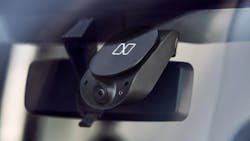Nauto, a provider of AI-powered dashcams, is collaborating with BrightDrop, a technology and electric vehicle company focused on decarbonizing last-mile deliveries, to allow BrightDrop's commercial fleet customers to have the option to add Nauto's predictive AI safety solutions to help improve driver safety performance, reduce collision loss, and save lives.
Nauto technology results in a 60-80% reduction in risky and distracted driving and a 50%- 80% reduction in collisions, according to a Nauto press release. Safety is a serious concern within the last-mile delivery segment, which differs from other driving environments because drivers must execute high-risk start, stop, and reverse maneuvers frequently in variable situations such as narrow urban streets, residential neighborhoods, and congested parking situations.
See also: Deterring distracted driving to save dollars and lives
"We're at a tipping point in the commercial vehicle industry where it's not only good for the environment, but it's economical to switch to an electric fleet," said Steve Hornyak, Brightdrop’s chief revenue officer. "BrightDrop's electric delivery vans can already save fleet owners thousands of dollars in operating costs. Now, our customers have the option to take advantage of Nauto's early warning alerts that can translate into critical extra seconds for drivers to react, helping to avoid collisions and reduce the costs that result from them."
Nauto CEO Stefan Heck said, "Our work with BrightDrop is groundbreaking on several fronts. Their innovative vehicles and deployments with blue chip companies in the last mile delivery segment, which is known for its roadway complexity in congested urban environments and high collision rates, have catalyzed fleet industry thinking around how AI technology like Nauto can make a dramatic dent in risk by preventing collisions before they happen. For drivers, receiving highly accurate early warnings creates trust, where Nauto is an effective and a reliable co-pilot that respects their privacy needs. Now fleets can make progress on both their zero emission and zero collision injury goals using one combined solution."
About the Author
FleetOwner Staff
Our Editorial Team
Kevin Jones, Editorial Director, Commercial Vehicle Group
Josh Fisher, Editor-in-Chief
Jade Brasher, Senior Editor
Jeremy Wolfe, Editor
Jenna Hume, Digital Editor
Eric Van Egeren, Art Director
